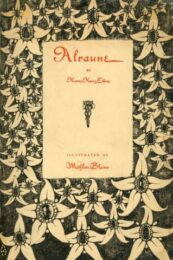By HANNS HEINZ EWERS (The John Day Company; 1911/29)
See also: ALRAUNE (Film)
ALRAUNE is probably the late, great German author Hanns Heinz Ewers’ masterpiece. It’s certainly the best volume of his Frank Braun trilogy, being the most focused and concise, and with a welcome surfeit of the lengthy philosophical and political digressions that characterized Braun’s exploits in THE SORCERER’S APPRENTICE (1910) and VAMPIRE (1927).
Here the aloof, decadent Braun, a law student, initiates a heap of trouble when one day he blithely suggests that his wealthy scientist uncle artificially create a woman, as outlined in the legend of the fertility powers of the mandrake (or alraune) root. Braun’s uncle, Jacob ten Brinken, takes to the plan and, with his nephew’s help, collects the semen of a condemned murderer, ejaculated at the moment of execution. He uses this to impregnate a prostitute appropriately monikered Alma Raune, and Alraune is born. Braun then disappears for over a hundred pages as Alraune grows up. From the start she’s a problem child, inspiring her classmates to torture animals in various horrific ways. It seems she has psychic powers, and can compel people to commit evil deeds with no tangible evidence that she herself did anything wrong. This points up another peculiarity of Alraune: she doesn’t appear to have much in the way of a soul.
Upon reaching adulthood, Alraune steps up her campaign of evil influence. An androgynous beauty, she drives several lovesick men to madness, ruin and death. This culminates with her own creator Mr. ten Brinken, who becomes amorously infatuated with Alraune and decimates himself and his family fortune trying to woo her.
Reenter Frank Braun, now a full-fledged lawyer called upon by his uncle’s will to be Alraune’s guardian. In the gleefully amoral Braun it seems Alraune has finally met her match—and an already smoldering tale catches fire. The two quickly become inseparable, entering into a vividly described sadomasochistic love affair that comes to involve brutality and blood drinking. Braun, who’s understandably harboring second thoughts about his newfound “love”, learns of Alraune’s apparently supernatural predilections when he spies her communing with the moon one night in a peculiarly worshipful manner…
Hanns Heinz Ewers was always noted for his interest in aberrant psychology, years before it became chic. This unsurprisingly made his work quite controversial in its time, particularly ALRAUNE, with its profane twisting of age-old Frankenstein mythos. A characteristically bold and unflinching work, it contains a veritable catalog of perversion: sadomasochism, pedophilia, nymphomania and incest.
Ewers was also a master of decadent grotesquerie of a peculiarly late nineteenth/early twentieth century variety. Oscar Wilde was a clear influence, as evinced by the distinctly Aubrey Beardsley-esque black and white illustrations of Mahlon Blaine.) The text is packed with moments of show-stopping outrageousness, including the nympho-maniacal Alma Raune’s lustful stripping-down early on, in which she cries “Whoever wants me may have me!”; the youthful Alraune forcing the master of the ten Brinken household to prostate himself before her and kiss her feet; the adult Alraune’s nude donkey ride; and the twisted sexuality of the concluding chapters, which remain unrivaled in their ghastly aberrance, and haven’t been properly dramatized in any of the numerous film adaptations of the novel (which include the classic 1928 silent version with Brigitte Helm, and the Erich von Stroheim-headlined UNNATURAL from 1953).
ALRAUNE (AKA UNNATURAL 1953 Trailer)
A large part of the novel’s power is due to the fluid 1929 English translation by the famed novelist and screenwriter Guy Endore (who also did the honors with Ewers’ VAMPIRE). The novel’s influence on Endore’s own writing, in particular his legendary WEREWOLF OF PARIS, is undeniable. But the fact remains that ALRAUNE itself has yet to be surpassed for color, audaciousness and sheer perversity.

